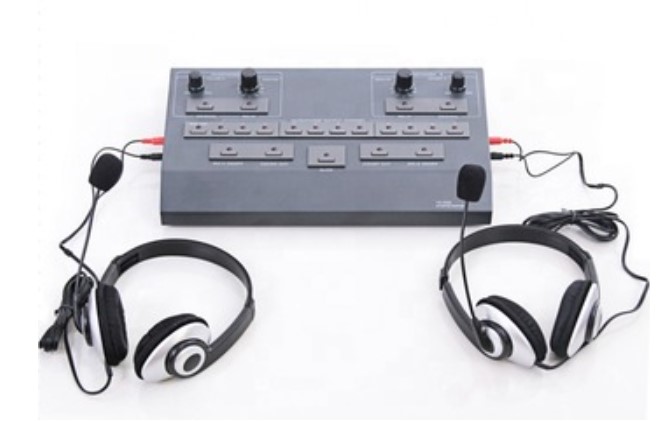5 differences between remote interpretation and conference interpretation

We all know, the world is becoming more and more digital and this process is going faster and faster. If it was fast before the Covid-19 pandemic, now, in the “new normality”, it's speeding up.
The interpretation (or oral or spoken translation) industry is one of many industries that have been affected by this new reality and have had to adapt. Let's make a brief introduction of these two basic forms of interpretation.
Índice de contenidos
Index of contents
Index du contenu
Inhaltsverzeichnis
Indice dei contenuti
Traditional conference interpretation
When we talk about traditional conference interpreting, we mean the type of interpreting in which the interpreters travel to the site where the conference is taking place.
Remote conference interpretation
Unlike traditional conference interpreting, in remote conference interpreting the interpreter does exactly the same as a traditional conference interpreter but from home.
And that's possible? With today's technology almost anything is possible, although it is important to note that it is not quite the same. There are some aspects that change in remote interpretation or translation with regards to on-site interpretation.
Let's see what the 5 main differences are between traditional conference interpretation and remote simultaneous interpretation.
1. Interpreter's workplace

As we have already said, the most notable difference is the workplace. While in traditional conference interpreting you work at the location where the conference is held, in remote conference interpreting you have two possible working options:
- Working from home
The first option for a remote interpretation or translation assignment is to work from home. But what does this entail?
To start with, the interpreter should have a good computer (if two screens, better), good headphones and a good Internet connection to dothe interpretation.
In addition, it will help to have the room soundproofed and everything that can make the quality of the interpretation the best possible. Also, the interpreters will need to use some of the multiple platforms that exist for this purpose. For example, today Zoom is already adapted for remote interpretation (remote translation).
- Working from a hub
When we refer to a hub, we mean an office or facility, which interpreters can go to for their remote interpreting or translation assignments.
Hubs are like offices, only instead of desks and computers there are interpreting booths that interpreters can use.
The only thing that differentiates a hub from a on-site interpreting assignment is that you see your speaker through a screen. As in traditional conference interpreting, in a hub the interpreter also works from an interpreting booth.
2. Interpreter's work tools

As expected, working in different places also means working with different tools:
In traditional conference interpreting, you usually work in the same way as in remote interpretation or translation from a hub.
In both cases, the interpreter has a soundproof booth with a glass panel on the front, through which they can see the speaker.

They also work with interpretation consoles and the usual equipment used in traditional conference interpretation. The only difference is that the remote interpreter receives a power signal via audio cable and a power signal via video cable from the speaker.

3. Interpretation logistics costs

In remote conference interpreting or remote translation, unlike traditional conference interpreting, the interpreter does not travel. And if it doesn't move, it means that as customers we don't have to bear the costs of travel, accommodation, etc.
On the other hand, the interpreter has more time, so he or she can take on more interpretation assignments. In this way, both parties benefit.
It also simplifies management. It is much easier to find an English to Norwegian translator or interpreter in Norway than in Spain.
4. Technical service to carry out the interpretation

Another area where traditional conference interpreting differs from remote conference interpreting or remote translation is that of technical service.
In conference venues there will generally be a technical team that can instantly solve any problems that may arise.
In remote interpreting, and especially if the interpreter works from home, it is more difficult to solve connection problems, etc. even if he or she has technical equipment, which is often not the case.
5. Carbon footprint of on-site and remote interpretation

This section has a lot to do with the section on logistical costs. It's about the carbon footprint of conference interpreters. As you know, the carbon footprint allows us to identify the amount of greenhouse gases emitted by an event, company, person, etc.
In traditional conference interpreting, or simply on-site interpretation, the interpreter has to travel. This means that many more greenhouse gases are emitted than in remote interpretation (or remote translation).
Therefore, we can conclude that remote interpretation contributes more to the survival of the planet than traditional on-site interpretation.
If you are interested in learning more about remote interpretation, I recommend our blog: “The challenge of remote interpretation.”
We have made clear the differences we can find between on-site and remoteinterpretation. Thefact that interpreters do not necessarily have to move around is the key difference.
Depending on our needs, infrastructure and budget, we can choose the type of interpretation that best suits us.
Other articles you may be interested in:

Josh Gambin holds a 5-year degree in Biology from the University of Valencia (Spain) and a 4-year degree in Translation and Interpreting from the University of Granada (Spain). He has worked as a freelance translator, in-house translator, desktop publisher and project manager. From 2002, he is a founding member of AbroadLink and is the Head of Sales and Strategy of the company.




Add new comment